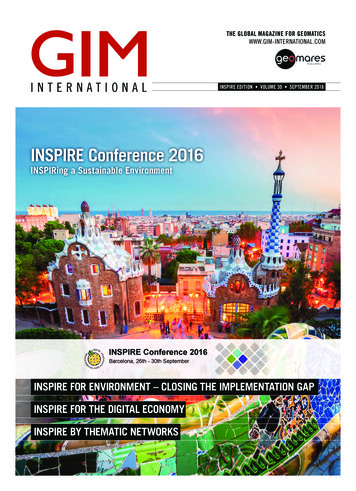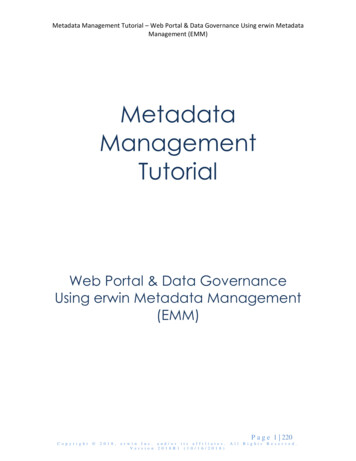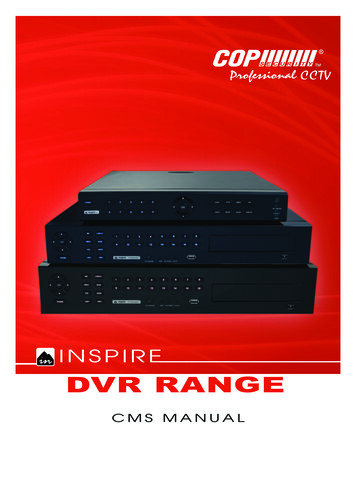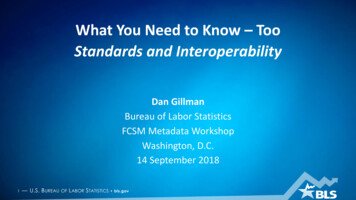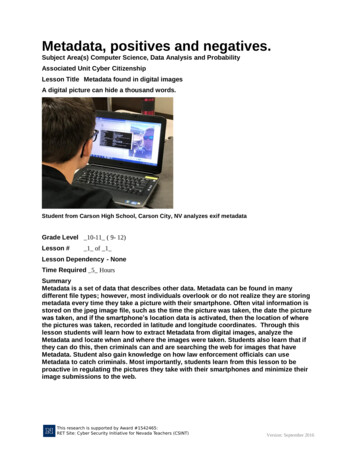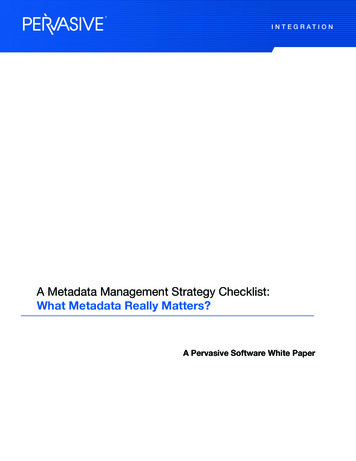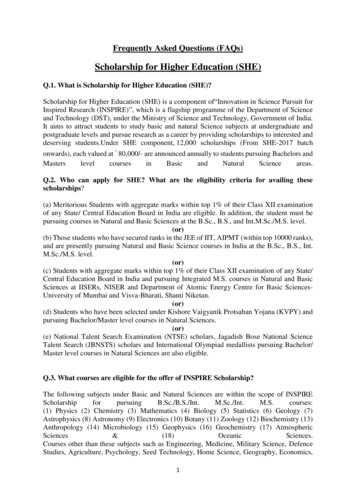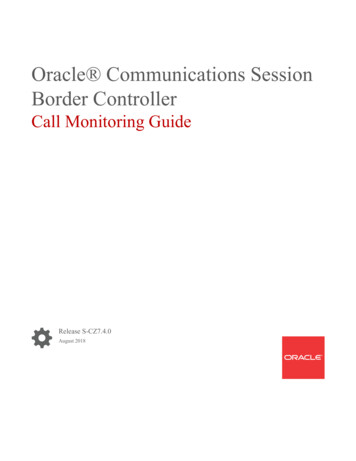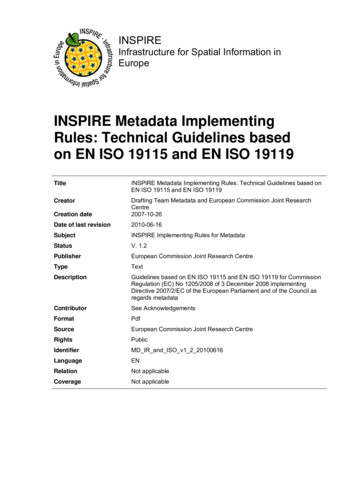
Transcription
INSPIREInfrastructure for Spatial Information inEuropeINSPIRE Metadata ImplementingRules: Technical Guidelines basedon EN ISO 19115 and EN ISO 19119TitleINSPIRE Metadata Implementing Rules: Technical Guidelines based onEN ISO 19115 and EN ISO 19119CreatorCreation dateDrafting Team Metadata and European Commission Joint ResearchCentre2007-10-26Date of last revision2010-06-16SubjectINSPIRE Implementing Rules for MetadataStatusV. 1.2PublisherEuropean Commission Joint Research CentreTypeTextDescriptionGuidelines based on EN ISO 19115 and EN ISO 19119 for CommissionRegulation (EC) No 1205/2008 of 3 December 2008 implementingDirective 2007/2/EC of the European Parliament and of the Council asregards metadataContributorSee AcknowledgementsFormatPdfSourceEuropean Commission Joint Research CentreRightsPublicIdentifierMD IR and ISO v1 2 20100616LanguageENRelationNot applicableCoverageNot applicable
Table of ContentsAcknowledgements. 4Introduction . 5Changes from Version 1.1 of 2009-02-18 . 5Normative references . 61 INSPIRE profile of ISO 19115 and ISO 19119. 71.1 ISO Core Metadata Elements. 71.1.1Spatial dataset and spatial dataset series . 71.1.2Services . 81.1.3Conclusion . 101.2 INSPIRE specific constraints. 101.3 Extensions . 111.3.1Spatial data service type. 111.3.2Classification of spatial data services . 112 Basic mapping . 122.1 Introduction . 122.1.1Xpath expression . 122.1.2ISO Schemas Location . 132.2 Identification. 142.2.1Resource title . 142.2.2Resource abstract. 152.2.3Resource Type. 162.2.4Resource locator. 172.2.5Unique resource identifier . 182.2.6Coupled resource. 192.2.7Resource language. 202.3 Classification of spatial data and services. 212.3.1Topic category . 212.3.2Spatial data service type. 222.4 Keyword. 232.4.1Keyword value . 242.4.2Originating controlled vocabulary . 262.5 Geographic location. 282.5.1Geographic bounding box. 282.6 Temporal reference . 302.6.1Temporal extent . 302.6.2Date of publication . 312.6.3Date of last revision . 322.6.4Date of creation. 332.7 Quality and validity . 342.7.1Lineage . 342.7.2Spatial resolution . 352.8 Conformity . 372.8.1Degree . 382.8.2Specification. 392.9 Constraints related to access and use . 412.9.1Limitations on public access . 422.9.2Conditions applying to access and use . 442.10Responsible organisation. 442.10.1 Responsible party . 452.10.2 Responsible party role . 462.11Metadata on metadata . 472.11.1 Metadata point of contact. 472.11.2 Metadata date . 482.11.3 Metadata language . 493 Detailed mapping. 503.1 Introduction . 503.2 Resource MetadataSet. 503.3 Identification Section . 513.3.1Sub-elements for spatial dataset and spatial dataset series . 513.3.2Sub-elements for service resources . 522
3.4 Data Quality Section. 533.4.1Lineage . 533.4.2Conformity. 533.5 Responsible Organisation . 543.5.1Resource responsible organisation . 543.5.2Metadata point of contact. 543.6 Constraint section . 543.7 Abbreviations . 55Annex A – ISO/TS 19139 encoding of the INSPIRE metadata elements . 56A.1Introduction. 56A.2From the conceptual schema to XML File instances . 56A.3Polymorphism. 56A.4Management of polymorphism. 56A.4.1Management of community extensions . 56A.4.2Parsing of metadata files . 56A.5Management of containment by reference . 57A.6ISO 19139 and multilingual metadata . 57A.6.1The default language . 58A.6.2Alternate languages . 59A.6.3Embedded translations . 59A.6.4Use of translation files. 60A.7Contexts of use . 61A.7.1Use of ISO 19139 in the context of a Catalogue Service . 61A.7.2Use of ISO 19139 in the context of the standard interchange by transfer. 61A.8Character encoding . 61A.9Temporal extent encoding. 61A.10Spatial resolution encoding . 63A.11Codelists. 64A.12Example of ISO 19139 XML Metadata Sets . 65A.12.1Dataset . 65A.12.2Dataset series. 71A.12.3Service. 713
AcknowledgementsMany individuals and organisations have contributed to the development of these Guidelines.The Drafting Team on Metadata included: Marcel Reuvers (Netherlands), Nicolas Lesage(France), Kristian Senkler (Germany), Michael Gould (Spain), Gil Ross (UK), Stefano Nativi(Italy), Jan Hjelmager (Denmark), Franz Daffner (European Environment Agency), PerRyghaud (Norway), Thomas Vögele and Fred Kruse (Germany), David Danko (USA).We are also grateful for the comments received during the consultation (28th May-15th June2010) with the Member Sates via their Points of Contact.The team at the Joint Research Centre who has contributed to these Guidelines include:Simon Cox, Massimo Craglia, Ioannis Kanellopoulos, Roberto Lucchi, Gianluca Luraschi, ,Michael Lutz, Michel Millot, Nicole Ostländer, Angelo Quaglia, Paul Smits, Robert Tomas.Contact informationMassimo Craglia (Editor)European Commission Joint Research CentreInstitute for Environment and SustainabilitySpatial Data Infrastructures UnitTP262, Via Fermi 2749I-21027 Ispra (VA)ITALYE-mail: massimo.craglia@jrc.ec.europa.euTel.: 39-0332-786269Fax: ww.jrc.ec.europa.eu/4
IntroductionAccording to Article 5(4) of Directive 2007/2/EC, the INSPIRE Implementing Rules shall takeaccount of relevant, existing international standards and user requirements. In the context ofmetadata for spatial data and spatial data services, the standards EN ISO 19115, EN ISO19119, and ISO 15836 (Dublin Core) have been identified as important standards.Commission Regulation (EC) No. 1205/2008 implementing Directive 2007/2/EC of theEuropean Parliament and of the Council as regards metadata was adopted on of 3rdDecember 2008, and published on the Official Journal of the European Union on 4thDecember (OJ L 326, 4.12.2008, p. 12–30). Any reference in this document to “ImplementingRules for Metadata” refers to the above mentioned Regulation.Regulation 1205/2008 has been amended with the corrigenda published in the OJ L 328/83 of15.12.2009 as follows: On page 12 delete the subtitle “Text with EEA relevance” (European Economic Area)On page 20, Annex D, point 1.3 replace “Spatial data services (services)” with“Spatial data services (service)”.PLEASE NOTE that in the course of this revision, another typing error has come to light in theRegulation 1205/2008 which will need a further amendment. In Part D 4, the language neutralname for element 501: Geoparameter calculation service should be(thematicGeoparameterCalculationService) and not(thematicGoparameterCalculationService) (part in bold is added to put in evidence the typingerror.The aim of this document is to define how the Regulation can be implemented using EN ISO19115 and EN ISO 19119. The following subsections describe for each element of theRegulation its relation with the mentioned European standards.This is an initial version of this document that will be developed further in collaboration withthe stakeholder community and relevant standardization organizations.This document will be publicly available as a ‘non-paper’, as it does not represent an officialposition of the Commission, and as such can not be invoked in the context of legalprocedures.Legal NoticeNeither the European Commission nor any person acting on behalf of the Commission isresponsible for the use which might be made of this publication.Changes from Version 1.1 of 2009-02-18This document is Version 1.2. The changes introduced since Version 1.1 are detailed in thedocument available ata/Changes to MD Guidelines from v11 to v1-2 20100616-1.pdf5
Normative referencesThe following referenced documents are indispensable for the application of this document.For dated references, only the edition cited applies. For undated references, the latest editionof the referenced document (including any amendments) applies.ISO 19115 designates these two normative references: EN ISO 19115:2005, Geographic information - Metadata1 ISO 19115/Cor.1:2006, Geographic information – Metadata, Technical Corrigendum 1ISO 19119 designates these two normative references: ISO 19119:2005, Geographic information - Services ISO 19119:2005/Amd 1:2008, Extensions of the service metadata modelISO 19108 designates: EN ISO 19108:2005, Geographic information – Temporal Schema2ISO 639-2, Codes for the representation of names of languages - Part 2: Alpha-3 codedacontrolISO 8601, Data elements and interchange formats - Information interchange - Representationof dates and timesISO/TS 19139:2007, Geographic information - Metadata – XML Schema ImplementationCSW2 AP ISO, OpenGIS Catalogue Services Specification 2.0.2 - ISO Metadata ApplicationProfile, Version 1.0.0, OGC 07-045, 2007ISO 10646-1, Information technology ― Universal Multiple-Octet Coded Character Set (UCS)― Part 1: Architecture and Basic Multilingual Plane12EN ISO 19115:2005 is the adoption by CEN of ISO 19115:2003EN ISO 19108:2005 is the adoption by CEN of ISO 19108:20026
1 INSPIRE profile of ISO 19115 and ISO 191191.1 ISO Core Metadata Elements1.1.1 Spatial dataset and spatial dataset seriesThe table below compares the core requirements of ISO 19115 (see Table 3 in 6.5 of ISO19115:2003) to the requirements of INSPIRE for spatial dataset and spatial dataset series asdefined in the Implementing Rules for metadata.ISO 19115 CoreINSPIRECommentsDataset title (M)Part B 1.1 Resource Title-Dataset reference date(M)Part B 5 TemporalReferenceISO 19115 is more demanding. Themetadata shall contain a date of publication,revision or creation of the resource, while inINSPIRE the Temporal Reference can alsobe expressed through Temporal Extent.Dataset responsible party(O)Part B 9 ResponsibleorganisationINSPIRE is more demanding by mandatingboth the name of the organisation, and acontact e-mail addressGeographic location of thedataset (C)Part B 4.1 GeographicBounding BoxINSPIRE is more restrictive. A Geographicbounding box is mandatedDataset language (M)Part B 1.7 ResourceLanguageISO 19115 is more demanding. It mandatesthe dataset language, even if the resourcedoes not include any textual information.The ISO 19115 Dataset language isdefaulted to the Metadata language.Dataset character set (C)-ISO 19115 is more demanding. The datasetcharacter set has to be documented in ISO19115 when ISO 10646-1 is not used.Dataset topic category (M)Part B 2.1 Topic Category-Spatial resolution of thedataset (O)Part B 6.2 SpatialResolution-Abstract describing thedataset (M)Part B 1.2 Resourceabstract-Distribution format (O)--Additional extentinformation for the dataset(vertical and temporal) (O)Part B 5.1 Temporal extentINSPIRE is more demanding. A temporalreference is mandated, and can beexpressed as a temporal extent.Spatial representationtype (O)--Reference system (O)--Lineage (O)Part B 6.1 LineageINSPIRE is more demanding. A generallineage statement is mandated.On-line resource (O)Part B 1.4 ResourceLocator-Metadata file identifier (O)--7
ISO 19115 CoreINSPIRECommentsMetadata standard name(O)--Metadata standard version(O)--Metadata language (C)Part B 10.3 MetadataLanguageINSPIRE is more demanding. The metadatalanguage is mandated even if it is definedby the encoding.Metadata character set(C)-ISO 19115 is more demanding. Themetadata character set has to bedocumented in ISO 19115 when ISO10646-1 is not used.Metadata point of contact(M)Part B 10.1 Metadata pointof contactINSPIRE is more demanding by mandatingboth the name of the organisation, and acontact e-mail address.Metadata date stamp (M)Part B 10.2 Metadata DateISO is more restrictive because this elementshall contain the “date that the metadatawas created” and INSPIRE may contain the“date when the metadata record wascreated or updated-Part B 1.3 Resource TypeINSPIRE is more demandingPart B 1.5 UniqueResource IdentifierINSPIRE is more demandingPart B 3 KeywordINSPIRE is more demanding-Part B 7 ConformityINSPIRE is more demanding-Part B 8.1 Conditions foraccess and useINSPIRE is more demanding-Part B 8.2 Limitations onpublic accessINSPIRE is more demanding1.1.2 ServicesThe table below compares the core requirements of ISO 19115 (see Table 3 in 6.5 of ISO19115:2003) to the requirements of INSPIRE for services as defined in the ImplementingRules for metadata. The greyed lines correspond to core metadata elements not applicable toservices.ISO 19115 CoreINSPIRECommentsDataset title (M)Part B 1.1 Resource Title-Dataset reference date(M)Part B 5 TemporalReferenceISO 19115 is more demanding. Despite itsname, this ISO 19115 Core metadataelement applies to services. A referencedate of the service (date of publication,revision or creation ) is mandated.Dataset responsible party(O)Part B 9 Responsibleorganisation-Geographic location of thedataset (C)-See INSPIRE Geographic Bounding Box8
ISO 19115 CoreINSPIREComments-Part B 4.1 GeographicBounding BoxThe Geographic Bounding Box is handled inISO 19119 with a different metadataelement from the one corresponding to“Geographic location of the dataset”Dataset language (M)-Not applicable to servicesDataset character set (C)-Not applicable to servicesDataset topic category (M)-Not applicable to servicesSpatial resolution of thedataset (O)Part B 6.2 SpatialResolutionIn the current version of ISO 19119, it is notpossible to express the restriction of aservice concerning the spatial resolutionAbstract describing thedataset (M)Part B 1.2 Resourceabstract-Distribution format (O)--Additional extentinformation for the dataset(O)--Spatial representationtype (O)--Reference system (O)--Lineage (O)--On-line resource (O)Part B 1.4 ResourceLocator-Metadata file identifier (O)--Metadata standard name(O)--Metadata standard version(O)--Metadata language (C)Part B 10.3 MetadataLanguageINSPIRE is more demanding. The metadatalanguage is mandated.Metadata character set(C)-ISO 19115 is more demanding. Themetadata character set has to bedocumented in ISO 19115 when ISO10646-1 is not used.Metadata point of contact(M)Part B 10.1 Metadata pointof contact-Metadata date stamp (M)Part B 10.2 Metadata DateISO is more restrictive because this elementshall contain the “date that the metadatawas created” and INSPIRE may contain the“date when the metadata record wascreated or updated-Part B 1.3 Resource TypeINSPIRE is more demanding-Part B 1.6 CoupledResourceOptional in INSPIRE-Part B 2.2 Spatial DataService TypeINSPIRE is more demanding9
ISO 19115 CoreINSPIRECommentsPart B 3 KeywordINSPIRE is more demanding-Part B 7 ConformityINSPIRE is more demanding-Part B 8.1 Conditions foraccess and useINSPIRE is more demanding-Part B 8.2 Limitations onpublic accessINSPIRE is more demanding1.1.3 Conclusion The conformance of an ISO 19115 metadata set to the ISO 19115 Core does notguarantee the conformance to INSPIRE;The use of these guideline to create INSPIRE metadata ensures that the metadata isnot in conflict with ISO 19115. However, full conformance to ISO 19115 implies theprovision of additional metadata elements which are not required by INSPIRE.Over the structural requirements formalised through the mappings, the conformance toINSPIRE is also a matter of semantic of the information provided. If it is acceptable that theISO 19115/ISO 19119 contain information which are not strictly bounded to the definition ofthe corresponding INSPIRE metadata elements, the minimum requirements expressed in theimplementing rules have also to be met semantically, i.e. with metadata contents strictlysatisfying the INSPIRE requirements.1.2 INSPIRE specific constraintsHere is an initial list of INSPIRE constraints applicable to an ISO 19115/ISO 19119 metadataset (i.e. an instance of MD Metadata) describing a resource:SC1. MD Metadata.language is mandatory;SC2. MD Metadata.hierarchyLevel is mandatory;SC3. INSPIRE only considers the first instance of MD Metadata.hierarchyLevel (i.e.MD Metadata.hierarchyLevel[1]) when there are many;SC4. If the value of MD Metadata.hierarchyLevel[1] is not service, dataset or series, themetadata set is out of scope of the directive;SC5. When there are many instances of MD Metadata.identificationInfo, only the first one(i.e. MD Metadata.identificationInfo[1]) concerns the current INSPIRE Resource;SC6. INSPIRE only considers the instance of MD Metadata.dataQualityInfo applicable to thewhole resource;SC7. There shall not be more than one instance ofMD Metadata.identificationInfo[1].MD Identification.citation.CI Citation.date declaredas a creation date (i.e. CI Date.dateType having the creation value);SC8. MD Metadata.identificationInfo[1].MD DataIdentification.citation.CI Citation.identifier ismandatory for metadata sets related to spatial dataset and spatial dataset series;SC9. The data type of MD Metadata.identificationInfo.MD DataIdentification.language is thecodelist LanguageCode from ISO/TS 19139;SC10.There is at least one instance ofMD Metadata.identificationInfo[1].MD DataIdentification.extent defining the geographiclocation of the resource as a geographic bounding box (i.e. an instance ofEX GeographicBoundingBox or one of its subclasses).SC11.MD Metadata.identificationInfo[1].SV ServiceIdentification.operatesOn shall beinstantiated by referenceSC12.There shall be at least one instance ofMD Metadata.identificationInfo[1].MD Identification.resourceConstraints10
SC13.The coordinates of the bounding boxes (instance of EX GeographicBoundingBox) shallbe expressed in any geodetic coordinate reference system with the Greenwich PrimeMeridianSC14.For datasets and series:MD Metadata.identificationInfo[1].MD DataIdentification.pointOfContact[1].CI ResponsibleParty.organisationName andMD Metadata.identificationInfo[1].MD DataIdentification.pointOfContact[1].CI ResponsibleParty.contactInfo.CI Contact.address.CI Address.electronicMailAddress aremandatory.For services these elements are also mandatory but they are referred as follows:MD Metadata.identificationInfo[1].SV ServiceIdentification.pointOfContact[1].CI ResponsibleParty.organisationName andMD Metadata.identificationInfo[1].SV ServiceIdentification.pointOfContact[1].CI ResponsibleParty.contactInfo.CI Contact.address.CI Address.electronicMailAddress.SC15.MD Metadata.contact[1].CI ResponsibleParty.organisationName andMD Metadata.contact[1].CI ResponsibleParty.contactInfo.CI Contact.address.CI Address.electronicMailAddress are mandatory.SC16.The value of MD Metadata.contact[1].CI ResponsibleParty.role.CI RoleCode shall bepointOfContact.SC17.For datasets and series at least one keyword of GEMET thesaurus shall bedocumented usingMD Metadata.identificationInfo[1].MD DataIdentification.descriptiveKeywords.SC18.For services at least one keyword of Part D.4 of Commission Regulation (EC) No.1205/2008 shall be documented usingMD Metadata.identificationInfo[1].SV ServiceIdentification.descriptiveKeywords1.3 Extensions1.3.1 Spatial data service typeFor spatial data service types, the Implementing Rules mandate the use of the value domainof Part D 3. This information is handled using the serviceType attribute (See 2.3.2) of theclass SV ServiceIdentification (See ISO 19119).The Table below defines the values of the serviceType property. In brackets are the languageneutral names to be used.SPATIAL DATA SERVICE TYPEDiscovery Service (discovery)View Service (view)Download Service (download)Transformation Service (transformation)Invoke Spatial Data Service (invoke)Other Services (other)1.3.2 Classification of spatial data servicesFor classification of spatial data services, the Implementing Rules mandate the use of thevalue domain of Part D 4 of Regulation 1205/2008. In order to ensure a languageindependent expression of the classification of spatial data services, the language neutralname is to be used as the value of the ISO 19115 keywords (See 2.4).11
2 Basic mapping2.1 IntroductionThe following tables describe the mapping between the metadata elements of INSPIRE, asdefined in the INSPIRE implementing rules for metadata, and ISO 19115/ISO 19119. Foreach of the INSPIRE Metadata element, the mapping is composed of: The main characteristics of the metadata element as they are defined3 in theINSPIRE implementing rules (IR) for metadata, i.e.:o The reference to the paragraph of the implementing rules describing themetadata element;o The name of the metadata element as used in the implementing rules;o The obligation/condition applicable to the metadata element;o The multiplicity of the metadata element. The main characteristics of the corresponding metadata element of ISO 19115 or ISO19119, i.e.:o The number that identifies the metadata element inside tables in ISO 19115(or ISO 19119) published standard;o The name by which the metadata element is known in ISO 19115 (or ISO19119) published standard;o The definition, which gives the current ISO 19115 or ISO 19119 terms fordescribing the metadata element (Annex B of ISO 19115 standard: DataDictionary for geographic metadata or Annex C of ISO 19119: Data dictionaryfor geographic service metadata);o An XPath expression indicating the metadata element within the ISO 19115 /ISO 19119 UML model (see 2.1.1).o An example that illustrates the description of the metadata element byproviding a concrete case. Some Implementing instructions, which give more warnings about theimplementation in the particular context of the current metadata element. An example of XML encoding, i.e. a fragment of the XML of a metadata recordcreated and validated with the INSPIRE Metadata Editor available from the EUGeoportal ).The overall structure of an ISO 19115/ISO 19119 metadata set supporting the requirementsexpressed in the INSPIRE Implementing rules for metadata is defined in Section 3 of thisdocument.2.1.1 Xpath expressionThis compact notation allows many defaults and abbreviations for common cases. Thesimplest XPath takes a form such as /A/B/C which selects C elements that are children of Belements that are children of the A element that forms the outermost element
The table below compares the core requirements of ISO 19115 (see Table 3 in 6.5 of ISO 19115:2003) to the requirements of INSPIRE for spatial dataset and spatial dataset series as defined in the Implementing Rules for metadata. ISO 19115 Core INSPIRE Comments Dataset title (M) Part B 1.1 Resource Title - Dataset reference date (M)

